Designer Spotlight: Charles Harbison on Class Identity & Collaborating with Banana Republic
November 22, 2021
Rashad Benton


Born in Lincolnton, a city northwest of Charlotte, North Carolina, Charles Harbison lives a life that many from his birthplace probably never imagined. It is said that our upbringings shape us for the rest of our lives – both in positive and negative ways. In Harbison’s case, his close-knit family keeps him grounded. His profile isn’t about sorrow, but education and artistic gift. It shows how support from your family at a young age can create a limitless imagination.
Such imagination turned a kid interested in architecture from an undergraduate student studying Fiber Arts and Textile Science at North Carolina State University into a well-read and well-traveled adult and graduate of Parsons School of Design. He’s built an impressive resume throughout his travels in Central Asia, where he taught for a year, and the time he spent working for Michael Kors, Kate Spade, and Billy Reid. Never mind the fact that he’s dressed Beyonce, Michelle Pfeiffer, and Ava Duvernay, or the fact that he’s been design director for other brands such as Ungaro in London, Cult Gaia & Nicholas in LA. The real icing on the cake is that Mr. Harbison has made it to a place where he feels seen and affirmed.
He’s telling his perspective on fashion with his own luxury brand HARBISON and his recent collaboration with Banana Republic. Today, the designer gets personal.
When and how did it all begin?
It began with the fact that I couldn’t keep a job. I worked at Michael Kors, Luca Luca, and then I launched womenswear at Billy Reid. I kept running into situations where my voice wasn’t valued at whichever company I found myself working at. The ideas and aesthetics I wanted to push forward were met with zero interest. HARBISON came about when I turned 30, a time where I was still contemplating whether I would step foot back into the workforce. I spent three months in St. Croix visiting my best friend during that time of “do I or don’t I.” That time away allowed me to rest, meditate, and think. I read a lot as well…Just Kids by Patty Smith and Notes of a Native Son by James Baldwin….
I decided to create a few samples, and I knew that at the very least, I could use those samples to get another job if the universe saw it that way. Fortunately, I had been a design director for years, which allowed me to build great factory contacts, making the sample process relatively easy. The hard part of all this was coaching and convincing myself to take the leap. Somehow, photos of my samples ended up on Anna Wintour’s step-daughter-in-law Kathryn Neale Shaffer’s desk at Vogue, and she reached out telling me that she really enjoyed them. My mentor Patrick Robinson showed those same samples to [his wife], Vogue‘s Fashion Director Virginia Smith, and not too long after, I was at the Vogue offices. I left that meeting being asked to provide a few more samples. So, I went back, designed a few more, held a small presentation that April at C24 Gallery, all of which led to my first feature in the September issue and my first account.
Have you always dreamed of having your own label?
It was a thought in the back of my head that it would be nice to have my own collection one day – largely born out of my independent studies while in undergrad. I would produce clothing and showcase them on my friends. Big fish, small pond situation. Truthfully, what I love more than having a collection is fashion design, so I was happy to work and create beautiful things at these various companies. I was learning, being challenged, and growing. It was great until I realized that my talent and skills were desired, but my presence was not.
Throughout my upbringing, I never grew up feeling silenced. So going into these spaces, being silenced and my presence not being wanted was a massive issue for me. It took me seven or eight years, but I finally realized that to have a more comprehensive human experience with the craft I love, I needed to build it on my own. So I did.
How would you define your idea of fashion?
I routinely say I want to give women, men, and humans the tools to aesthetically present themselves to the world with more power and elegance. That’s important to me, so when I think about fashion, I take the skills I’ve picked up and utilize them to help people build the visual presence of themselves that they wish to bestow to the world. Fashion is the thing that communicates for and about you before you even open your mouth.
Your collaboration with Banana Republic – tell me how this came about?
Banana Republic connected with Brandice Daniel, the Founder/CEO of Harlem’s Fashion Row, to call designers to submit themselves and their work for a collaboration centered around sustainability. I had sworn off competitions in the past because I unjustifiably lost several, which led me to have a disdain for them. But with Brandice and Harlem’s Fashion Row at the helm of this, I figured if there’s ever an entity in fashion who will see me in my work without issue, it’s this organization. There was such fantastic synergy with the brand, and I’m hoping it comes through the pieces. It’s my wish that this collab communicates optimism, joyfulness, and a Black fem affirmation for all people. I think we did it!
I went to the Banana Republic website when I learned about your collaboration, but nothing was for me. Any interest in designing menswear?
There’s a safari suit from the collection that was cut as a gender-neutral set. I cut it to fit myself, and it’s the same one my mother wore in the campaign. This piece really focuses on inclusivity. You aren’t seeing it because it is late and isn’t in stores yet, but it will be there soon in both chocolate and cream. There’s a blue suit that is late as well that is also gender-neutral, so it definitely crossed my mind, and if the response is loud enough, it will be produced for men too. I’m working hard to bring menswear to the masses with my brand HARBISON.Studio.
How has your work evolved since you began your own label?
The more I live in the world and live-in clothes, the more thoughtful I’ve become about how my pieces are lived in. When I was younger, I was highly consumed with the aesthetic, and for a good reason, right? That’s where much of the excitement in fashion comes from: the visual! I was trained in Fine Arts, so I was bringing painting and product design references to my design. Today, my approach is more comprehensively thoughtful regarding bodies and how individuals feel in the product. My goal is to make vintage. I want my clothes to be around long enough for someone to say their mother or grandmother wore this. I learned that approach, I believe, from a Tom Ford interview.
The inclusion of your mother and people close to you are at the forefront of the BR x HARBISON campaign. Is this something you immediately knew you wanted to do?
100 percent! This collaboration allowed me to reach the people in my life in ways I hadn’t been able to before. The brands I worked at and HARBISON itself are all premium-priced, so I hadn’t had a chance to get the product in the hands of my family in a natural way without me having to gift them. It was also about producing products for those with a similar class issue/insecurity. Banana Republic provided a giant leap in that direction, and I knew instantly I wanted to center those women I’ve been seeking to get to. I missed my mother dearly, and this was all happening in the thick of COVID. It had been almost two years since I last saw her, and this was another way to bring us together as I was also dealing with my grandmother’s passing.
You’ve mentioned class identity a few times throughout this interview. If willing, can you speak to what class identity issues you have?
Sure, it’s me affirming how I was domesticated in the world. No matter what level I reach or what I accrue in life, I want to affirm others who have or had that same experience in the world. I want them to know that they can and will do the things they want to do no matter what the conditions say. There’s a utilitarian sense that comes out of growing up working class. There’s a focus on excellence and craft, a lack of retention, a connectedness to one another, a sense of sharing, and an inherent understanding of sustainability and thoughtful usage. There are a million beautiful things about that identity.
Last one: What are you most looking forward to as your progress as a designer?
I’m looking forward to continued growth, particularly with the team I have now. We’re a small sprite group. I’m excited to see us achieve and expand more and more. Also, I’m excited to introduce more of the world to Harbison.
IG: @charlienchargie
Photo by Lee Morgan @Leemorganphoto

